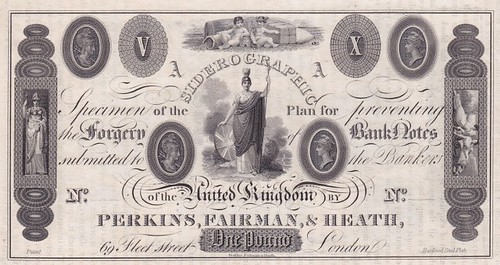
PREV ARTICLE
NEXT ARTICLE
FULL ISSUE
PREV FULL ISSUE
ON SIDEROGRAPHIC BANK NOTE PRINTINGDavid Gladfelter submitted these thoughts about the numismatic term 'siderographic'. Thanks! -Editor
 The term “siderographic” has been in use since the 1820s, according to this advertising note of Perkins, Fairman and Heath of London. A similar note is in Stack’s-Bowers 2015 New York International Numismatic Convention sale, lot 2102. Also see lot 2095 in that sale, a brochure on Perkins and Fairman’s “patent siderographic plan” published in 1819. What does the term “siderographic” mean? I was unable to locate a dictionary definition. The Greek word sidiros means iron (the metal), per R. Scott Carlton’s International Encyclopædic Dictionary of Numismatics. The words siderographic, siderographer, siderography are probably derived from this Greek word. So the literal meaning must be something similar to “graphic arts of (or produced by means of) iron (or steel).” In his 2009 book The Feel of Steel, Mark Tomasko explains the term. Under the topic “transferring,” Tomasko says: “The invention of the transfer process [from an intaglio vignette on a master die, to a relief impression of the vignette on a roller die, to an intaglio image on a printing plate] was a critical advance for bank note engraving. The process is known formally as siderography and was unique to the bank note engraving industry.” Prior to leaving the United States for England, Jacob Perkins patented a stereotype steel plate for printing bank notes, and obtained a legislative monopoly in the Commonwealth of Massachusetts for the use of such plates in printing all bank notes of the $1, $2, $3 and $5 denominations. Perkins wrote this up in a brochure titled “Perkins’ Bank Bill Test; Consisting of Original Impressions from the Permanent Stereotype Steel Plates … “ (etc.) On June 15, 1813, Perkins also patented a transfer press for making multiple copies of hand-engraved images onto steel printing plates by means of a roller die, per Greville and Dorothy Bathe’s 1943 biography of Perkins, published by the Historical Society of Pennsylvania. Shown is a drawing of this transfer press and roller die taken from a plate in Bathe.  Perkins’s argument for the superiority of the steel plates was that it would achieve “a perfect uniformity in Bank Bills,” apparently the anticipated result of the improved durability of the steel plates when compared with the copper plates then in use. And with the bills’ designs being replicable among different banks by means of siderography, bills of many banks could be made uniform. Interestingly, the term “siderographer” did not catch on with the artisans themselves. Their trade union was named the International Steel Plate Transferrers Association of America. Early in the 20th century they joined what is now the International Plate Printers, Die Stampers, Plate Makers and Engravers Union of North America, whose attractive souvenir convention booklets of engravings have become quite collectible. THE BOOK BAZARREWayne Homren, Editor The Numismatic Bibliomania Society is a non-profit organization promoting numismatic literature. See our web site at coinbooks.org. To submit items for publication in The E-Sylum, write to the Editor at this address: whomren@gmail.com To subscribe go to: https://my.binhost.com/lists/listinfo/esylum All Rights Reserved. NBS Home Page Contact the NBS webmaster 
|